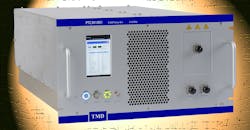Download this article as a .PDF
Defense systems contain a great deal of hardware that requires high-power RF/microwave signals for testing, whether in communications systems, electronic-warfare (EW), or radar systems. In addition, high-power test signals are often needed for electromagnetic-compatibility (EMC) or radio-frequency-interference (RFI) testing of high-frequency components and systems.
For robust power levels, instrumentation amplifiers based on traveling-wave-tube (TWT) active devices can 1217provide the necessary output-power levels across the required bandwidths. TMD Technologies Ltd. has just unveiled its PTCM line of TWT-based instrumentation amplifiers that provide as much as kilowatts of power for selected bandwidths to 40 GHz, but are more than “just” amplifiers, with many self-monitoring and self-protection features that ensure long and reliable service lives for these TWTAs.
The PTCM TWTA instrumentation amplifiers (see photo) are housed in a standard, 6-u-high 19-in. rack-mount enclosure that allows multiple units to be combined in an instrument rack to achieve required frequency ranges and power levels. Amplifiers are available for total frequency coverage of DC to 40 GHz and as much as 50 kW peak output power, although the output levels of individual, standard units are much more conservative and for more limited bandwidths.
As an example, model PTCM1004 is a rack-mount TWTA for applications from 2 to 6 GHz. It provides 200 W minimum output power across that frequency range, with typical output power of 250 W for pulsed or CW signals. For somewhat higher frequencies, model PTCM1008 covers a frequency range of 6 to 18 GHz, with 300 W minimum output power and 320 W typical output power for pulsed or CW signals. At the high-frequency end of the total frequency range, model PTCM1018 delivers 40 W minimum output power, and typically 80 W output power from 18 to 40 GHz, for pulsed or CW signals.
The instrumentation amplifiers are quite robust, weighing 47 kg and with a length of 800 mm. The company’s long history in electron tube technology, including klystrons and TWTs, is apparent in the thermal design of the PTCM instrumentation amplifiers, which incorporate heat-pipe technology to spread the heat produced by each TWT over large areas within the enclosure. The advanced thermal management reduces peak temperatures and minimizes opportunities for “hot spots,” improving the mean time before failure (MTBF) of the amplifiers in the process. The TWTAs are designed for an operating temperature range of 0 to +40ºC.
The high-power instrumentation amplifiers are built to last, with a host of self-diagnostic routines and built-in over-VSWR protection. They are also equipped with plug-and-play field-replaceable power supplies to simplify the task should repairs be needed. They include Ethernet interfaces for wired or wireless connection to a PC for monitoring and remote control, and are fortified by a PC-based software tool that monitors and displays primary operating parameters, such as VSWR, pulse width, pulse repetition frequency (PRF), duty cycle, TWT temperature, and power-supply temperature. The amplifiers meet the standards for RTCA/DO-160, MIL-STD-810G, EUROCAE, and AIRBUS ABD 100.
TMD Technologies Ltd., Swallowfield Way, Hayes, Greater London UB3 1DQ, United Kingdom; +44 (0) 20 8581 5116
About the Author
Jack Browne
Technical Contributor
Jack Browne, Technical Contributor, has worked in technical publishing for over 30 years. He managed the content and production of three technical journals while at the American Institute of Physics, including Medical Physics and the Journal of Vacuum Science & Technology. He has been a Publisher and Editor for Penton Media, started the firm’s Wireless Symposium & Exhibition trade show in 1993, and currently serves as Technical Contributor for that company's Microwaves & RF magazine. Browne, who holds a BS in Mathematics from City College of New York and BA degrees in English and Philosophy from Fordham University, is a member of the IEEE.

